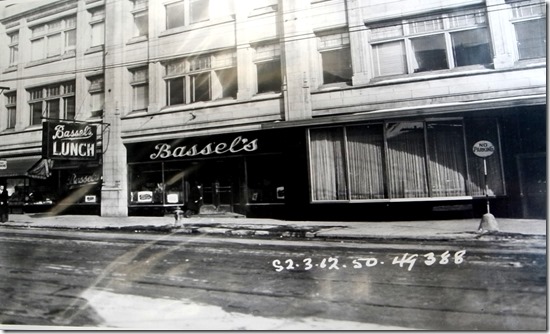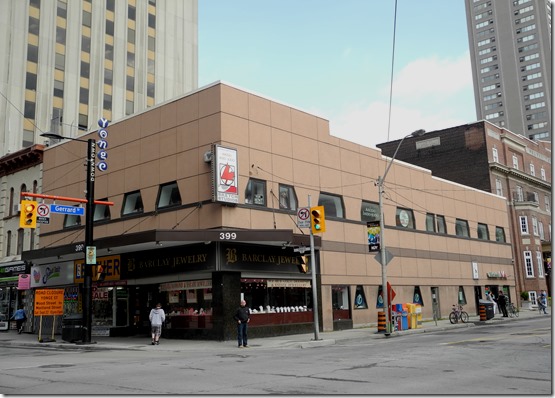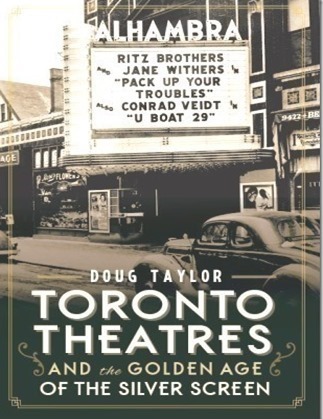The Coronet Theatre on the northeast corner of Gerrard and Yonge Streets in 1979. Double bill included—“Oh God” with George Burns, John Denver and Donald Pleasance, as well as “Turn You Every Which Way but Loose” with Clint Eastwood. (Photo, City of Toronto Archives, Series 1465, Fl. 310, It. 2 )
The Coronet Theatre at 399 Yonge Street was originally named “The Savoy. When it opened on 15 February in 1951, it was considered an ultra-modern addition to the Biltmore Chain. The architect was S. Devore of Toronto. The first film screened at the theatre was a double bill—“Mr. Universe, starring Bert Lahr and Robert Alda, as well as “Tough Assignment” with Don Barry and Steve Brody. Because it competed with larger and more prominent theatres such as the Imperial and Loew’s Downtown, it screened two feature films, and later three, for the price of one ticket. The larger theatres on the the strip showed first-run films so only offered one feature.
In 1963, the Odeon chain leased the theatre and changed its name to the Coronet. In 1978, the theatre was seized by the Sheriff of York County; it is assumed that this was for non-payment of either taxes or rent. Real estate prices were high on Yonge Street, and it was reported that mortgage payments on the building were $20,000 per month. The 700-seat theatre was sold and it became a no-frills theatre, showing five movies for the admission price of $3.50. The films commenced showing at noon. The movies were often violent, but fortunately there were few reports of problems with customers. However, during the showing of a Led Zeppelin film, the projector broke down and there was almost a riot. The police were called, but not before a young girl at the candy counter yelled, “Shaddap and sid-down.” In 1980, the theatre had a 3-D fest.
It was said that during the latter days of the theatre, patrons brought in pizza, chicken, beer, liquor and even a few pets. Just to clarify, the pets were not part of the menu.
In 1983, the theatre was sold for over a million dollars and the building was converted into a mini-mall for jewellers. This necessitated gutting the building. The walls were retained, but windows added on the second floor. There were 58 booths for jewellers in the space that had once been the auditorium. Above them, were 20 offices for gemologists and diamond setters.
The shell of the building remains today, a reminder of the theatre that it once contained.
The Savoy Theatre in the early 1950s, before it was renamed the Coronet Theatre. The main feature on the marquee is “Federal Man,” released in 1950. The second feature is “The Three Godfathers,” starring John Wayne, which was released in 1948. It is a western directed by John Ford.
The interior of the Coronet (photo from the Archives of Ontario, AO2274)
The Coronet when it was the Jewellery Exchange (photo City of Toronto Archives)
Looking east along Gerrard Street, across Yonge St., when the subway was under construction in 1952. One of the films playing was “Rawhide,” with Tyrone Power. The construction reduced the foot-traffic on Yonge Street, creating a loss in attendance at all the movie houses on the street. The marquee of the theatre in the above photo, then still named the Savoy, is on the northeast corner of the intersection. On the southeast corner was Basil’s Restaurant. (Photo, City of Toronto Archives, Series 0574, S. 054, fl. 1082, id491033)
Basel’s at Yonge and Gerrard in March of 1952. Yonge Street is covered with wood planking due to the subway construction below the street. I can still recall the Club Sandwiches at this restaurant. (City of Toronto archives, TTC Collection, Series 1278, File 115)
The building that housed the Coronet Theatre in 2013. The marquee remains as a reminder that the building was at one time a theatre.
To view the Home Page for this blog: https://tayloronhistory.com/
Links to other posts about the history of Toronto and its buildings:
https://tayloronhistory.com/2013/10/08/links-to-historic-architecture-of-torontotayloronhistory-com/
Links to posts about Toronto’s movie houses—past and present.
https://tayloronhistory.com/2013/10/09/links-to-toronto-old-movie-housestayloronhistory-com/
Recent publication entitled “Toronto’s Theatres and the Golden Age of the Silver Screen,” by the author of this blog. The publication explores 50 of Toronto’s old theatres and contains over 80 archival photographs of the facades, marquees and interiors of the theatres. It also relates anecdotes and stories from those who experienced these grand old movie houses.
To place an order for this book:
Theatres Included in the Book
Chapter One – The Early Years—Nickelodeons and the First Theatres in Toronto
Theatorium (Red Mill) Theatre—Toronto’s First Movie Experience and First Permanent Movie Theatre, Auditorium (Avenue, PIckford), Colonial Theatre (the Bay), thePhotodome, Revue Theatre, Picture Palace (Royal George), Big Nickel (National, Rio), Madison Theatre (Midtown, Capri, Eden, Bloor Cinema, Bloor Street Hot Docs), Theatre Without a Name (Pastime, Prince Edward, Fox)
Chapter Two – The Great Movie Palaces – The End of the Nickelodeons
Loew’s Yonge Street (Elgin/Winter Garden), Shea’s Hippodrome, The Allen (Tivoli), Pantages (Imperial, Imperial Six, Ed Mirvish), Loew’s Uptown
Chapter Three – Smaller Theatres in the pre-1920s and 1920s
Oakwood, Broadway, Carlton on Parliament Street, Victory on Yonge Street (Embassy, Astor, Showcase, Federal, New Yorker, Panasonic), Allan’s Danforth (Century, Titania, Music Hall), Parkdale, Alhambra (Baronet, Eve), St. Clair, Standard (Strand, Victory, Golden Harvest), Palace, Bedford (Park), Hudson (Mount Pleasant), Belsize (Crest, Regent), Runnymede
Chapter Four – Theatres During the 1930s, the Great Depression
Grant ,Hollywood, Oriole (Cinema, International Cinema), Eglinton, Casino, Radio City, Paramount, Scarboro, Paradise (Eve’s Paradise), State (Bloordale), Colony, Bellevue (Lux, Elektra, Lido), Kingsway, Pylon (Royal, Golden Princess), Metro
Chapter Five – Theatres in the 1940s – The Second World War and the Post-War Years
University, Odeon Fairlawn, Vaughan, Odeon Danforth, Glendale, Odeon Hyland, Nortown, Willow, Downtown, Odeon Carlton, Donlands, Biltmore, Odeon Humber, Town Cinema
Chapter Six – The 1950s Theatres
Savoy (Coronet), Westwood
Chapter Seven – Cineplex and Multi-screen Complexes
Cineplex Eaton Centre, Cineplex Odeon Varsity, Scotiabank Cineplex, Dundas Square Cineplex, The Bell Lightbox (TIFF)
![800px-Coronet_Theatre_Yonge_and_Gerrard_Streets_1979_Toronto[1] 800px-Coronet_Theatre_Yonge_and_Gerrard_Streets_1979_Toronto[1]](https://tayloronhistory.com/wp-content/uploads/2013/09/800px-coronet_theatre_yonge_and_gerrard_streets_1979_toronto1_thumb.jpg)
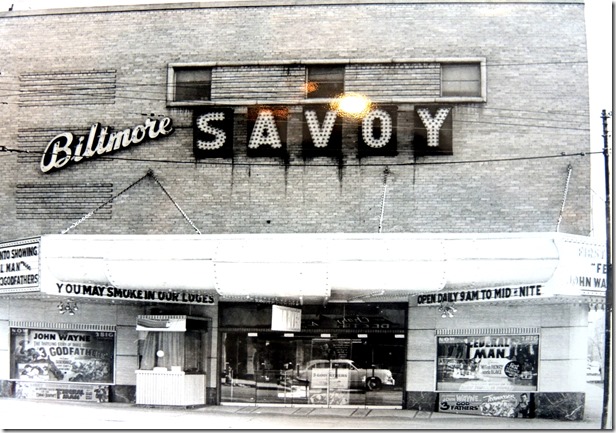

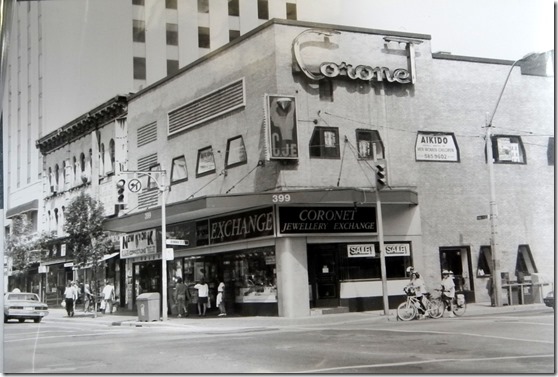
![large[1] Coronet-Savoy large[1] Coronet-Savoy](https://tayloronhistory.com/wp-content/uploads/2013/09/large1-coronet-savoy_thumb.jpg)
